

A Midsummer Night’s Dream – Planning Overview
Written by Dan
Last updated January 3, 2024
Are you a teacher looking for something fun and educational to teach your students this summer? Why not bring them on a fantastic journey with Shakespeare’s A Midsummer Night’s Dream? It is one of Shakespeare’s most beloved comedies, full of jokes, love stories, and magical adventures.
With the right approach, you can bring to life a classic tale that has delighted audiences for centuries. In this blog post, we will provide an overview of how to plan an engaging lesson on A Midsummer Night’s Dream in preparation for the upcoming summer season!
Related : For more, check out our Planning Overview of Clockwork by Philip Pullman here.

Table of Contents
Central Themes in A Midsummer Night’s Dream
A Midsummer Night’s Dream is a play written by William Shakespeare. The main themes that come up in the play include love, magic, illusion, and transformation. These themes are explored through the different characters and their experiences throughout the space.
Characters and Their Storylines
- Theseus : Duke of Athens who is preparing to marry Hippolyta. He represents the rational and logical side of society.
- Hippolyta : Queen of the Amazons who is set to marry Theseus. She represents the natural world and its power.
- Egeus : Father of Hermia who wants her to marry Demetrius. He represents societal expectations and authority.
- Hermia : In love with Lysander but forced by her father to marry Demetrius. She represents rebellion against societal norms.
- Lysander : In love with Hermia but faces opposition from Egeus and Demetrius. He represents true love and loyalty.
- Demetrius : Originally in love with Helena but later pursues Hermia under pressure from Egeus. He symbolises societal pressure and conformity.
- Helena : In love with Demetrius but rejected by him for Hermia. She represents unrequited love and jealousy.
- Oberon : King of the Fairies who tries to help resolve the lovers’ quarrels using magic. He represents power, control, and intervention.
- Titania : Queen of the Fairies who uses magic to assert her dominance over Oberon. She symbolises nature’s unpredictability and strength.
- Puck (Robin Goodfellow) : Mischievous fairy servant of Oberon who creates chaos through his use of magic. He symbolises trickery, mischief, and humour.
Overall, A Midsummer Night’s Dream is a complex play that explores various themes through its diverse characters. Through their different storylines, we see how societal expectations clash with individual desires, how love can be both transformative and unpredictable, and how nature can exert its power over human affairs through magical intervention.
The Symbolic Significance Of Theseus
Theseus, the Duke of Athens, plays a significant symbolic role in A Midsummer Night’s Dream. He represents society’s rational and logical side and the ideals of law and order. Theseus is associated with the city and civilisation, contrasting the natural world defined by the forest outside Athens.
In the play, Theseus is a foil to characters like Oberon and Titania, who are associated with nature and magic. His presence reinforces the idea that there is a clear divide between civilisation and nature, reason and emotion. However, this division is challenged throughout the play as characters like Hermia and Lysander rebel against societal expectations in favour of their desires.
Additionally, Theseus’ impending marriage to Hippolyta represents a union between two different cultures – Greek (Theseus) and Amazonian (Hippolyta). This can be seen as a metaphor for merging various aspects of society or other parts of an individual’s psyche.
Overall, Theseus’ symbolic significance lies in his representation of societal norms and expectations. While he may initially seem rigid in his adherence to these ideals, his character highlights how these norms can be challenged and subverted through an individual agency.
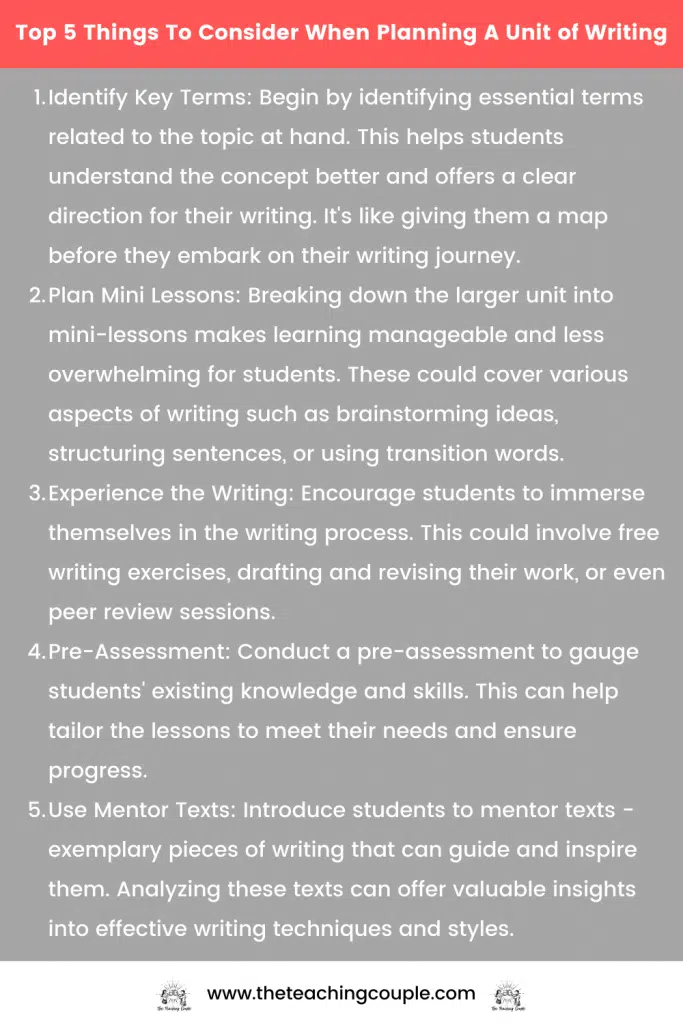
How Hermia and Lysander rebel against societal expectations
In A Midsummer Night’s Dream, characters like Hermia and Lysander rebel against societal expectations in several ways.
Firstly, Hermia refuses to marry the man her father has chosen for her, Demetrius and instead decides to pursue a relationship with Lysander. This goes against the societal expectation that she must obey her father and marry the man he has chosen for her.
Secondly, Lysander also rebels against societal expectations by loving Hermia despite her father’s objections. He defies the norm that men should follow their fathers’ wishes regarding marriage.
Furthermore, Hermia and Lysander choose to run away from Athens into the forest rather than accept the consequences of their rebellion. They reject the authority of Theseus and Egeus and seek refuge in an alternative world where they can pursue their desires freely without fear of repercussions.
Their actions challenge traditional societal norms surrounding arranged marriages and the power dynamics between parents, children, and romantic partners. Their rebellious spirit ultimately leads them to find true love and happiness outside these restrictive structures.
Overall, Hermia and Lysander’s rebellion highlights the importance of individual agency in shaping one’s destiny, even in the face of powerful societal pressures.
Learning Opportunities
When teaching A Midsummer Night’s Dream, several learning opportunities can be brought into the classroom. These opportunities can help students engage with the play more deeply and develop critical thinking skills.
- Historical Context: Teachers could provide historical context to help students understand Shakespeare’s social and political climate. This context includes information about Elizabethan England, the monarchy, and popular beliefs during that era.
- Literary Analysis: Teachers could introduce literary analysis techniques such as symbolism, imagery, and themes to help students understand how Shakespeare uses language to convey his ideas. Students can analyse specific passages from the play to identify these literary devices.
- Performance: Teachers could encourage students to perform scenes from the play in class or in front of an audience. This exercise allows students to explore character development and dialogue while improving their public speaking skills.
- Creative Writing: Teachers could assign creative writing tasks such as writing alternate endings or creating modern adaptations of the play. This task encourages students’ creativity while allowing them to practice their writing skills.
- Critical Thinking: Teachers could facilitate discussions around themes such as love, power, gender roles, and societal norms depicted in the play. These discussions allow students to think critically about these issues both within the context of the space and in contemporary society.
By incorporating these learning opportunities into their lessons, teachers can make A Midsummer Night’s Dream more accessible and engaging for their students while promoting critical thinking skills across various disciplines.
Literary Devices In A Midsummer Night’s Dream
Shakespeare uses a variety of literary devices and techniques in A Midsummer Night’s Dream to convey his ideas and enhance the play’s overall impact. Some of these include:
- Imagery: Shakespeare uses vivid imagery throughout the play to create a sense of fantasy and magic, particularly in the scenes set in the forest. For example, he describes the fairies as having “gossamer wings” and wearing “melted rubies” and “spangled starlight.”
- Metaphor: The play is full of metaphorical language that helps to convey complex ideas about love, power, and identity. For instance, when Theseus says that “the lunatic, the lover, and the poet are of imagination all compact,” he uses a metaphor to suggest that these three groups share an imaginative nature.
- Irony: Shakespeare employs irony throughout the play to add depth and complexity to his characters’ actions and motivations. For instance, when Demetrius says he loves Hermia but then pursues Helena instead, it creates an ironic situation highlighting love’s fickle nature.
- Foreshadowing: Shakespeare uses foreshadowing to hint at future events in the play. For example, when Puck says that “Lord what fools these mortals be!” early on in Act III, it foreshadows the chaos that will ensue when he puts spells on various characters later in the act.
- Symbolism: The play is rich with symbolism that adds layers of meaning to its themes and characters. For example, Bottom’s transformation into an ass symbolises his foolishness and lack of self-awareness.
Foreshadowing In Act III
There are several examples of foreshadowing in Act III of A Midsummer Night’s Dream. Here are a few:
- Puck’s line “Lord, what fools these mortals be!” is a clear example of foreshadowing, as it hints at the chaos that will ensue when he puts spells on various characters later in the act.
- When Demetrius and Helena enter the forest, Demetrius says to Helena: “I’ll run from thee and hide me in the brakes / And leave thee to the mercy of wild beasts.” This line foreshadows that he will be put under a spell later in the scene and fall in love with her.
- When Oberon asks Puck if he has found an Athenian youth in the woods, Puck replies: “The king doth keep his revels here tonight; / Take heed the Queen come not within his sight.” This line foreshadows that Titania will soon arrive on the scene and become involved in the conflict between Oberon and Titania.
- The fact that Bottom has been transformed into an ass also serves as a form of foreshadowing, as it hints at the absurdity and chaos resulting from Puck’s meddling with human affairs.
Example Lesson Plan
Title: Exploring the Themes and Literary Devices in A Midsummer Night’s Dream
Grade level: High School (9th-12th)
Objectives:
- Students can identify and analyse critical themes in A Midsummer Night’s Dream.
- Students will be able to identify and analyse various literary devices used by Shakespeare in the play.
- Students can apply their understanding of these themes and literary devices to create written initial responses.
- Copies of A Midsummer Night’s Dream
- Whiteboard and markers
- Handout on literary devices (e.g. metaphor, imagery, foreshadowing)
- Writing prompts or worksheets for individual or group work
- Introduction (10 minutes) Begin by introducing the play and its historical context. Discuss how Shakespeare wrote during the Elizabethan era and how his plays reflect that period’s social norms and values. Provide a summary of the plot of A Midsummer Night’s Dream.
- Identifying Themes (20 minutes) Next, divide students into small groups and assign each group one of the following themes from the play: love, power, identity, and illusion vs reality. Have them read through specific scenes in Act I-II that relate to their assigned theme and discuss how that theme is represented in those scenes.
- Analysing Literary Devices (30 minutes) After discussing themes, introduce students to various literary devices Shakespeare uses, such as metaphor, imagery, foreshadowing etc. Use examples from the play to explain each device.
- Applying Knowledge (30 minutes) Provide students with writing prompts or worksheets that ask them to use their understanding of themes and literary devices to create originally written responses, such as a short story based on one of the characters or scenes from the play or an analysis of how Shakespeare uses a particular device like symbolism.
- Conclusion (10 minutes) Wrap up by having students share some of their written responses with the class or allow them to discuss what they have learned.
Assessment: Assess student learning through class participation during group discussions and completion of writing assignments, demonstrating an understanding of the play’s themes and literary devices.
Related Posts
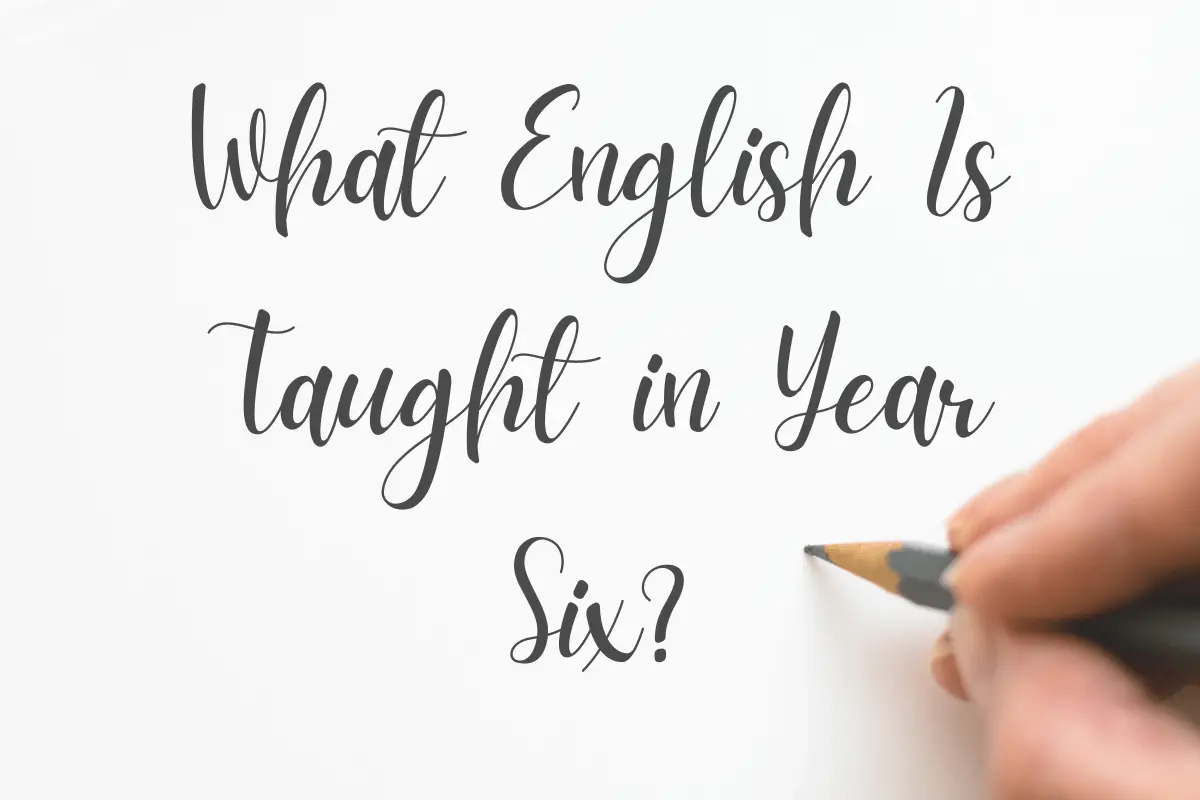
About The Author
I'm Dan Higgins, one of the faces behind The Teaching Couple. With 15 years in the education sector and a decade as a teacher, I've witnessed the highs and lows of school life. Over the years, my passion for supporting fellow teachers and making school more bearable has grown. The Teaching Couple is my platform to share strategies, tips, and insights from my journey. Together, we can shape a better school experience for all.
5 thoughts on “A Midsummer Night’s Dream – Planning Overview”
- Pingback: Romeo and Juliet - Planning Overview - The Teaching Couple
- Pingback: Hamlet - Planning Overview - The Teaching Couple
- Pingback: King Lear - Planning Overview - The Teaching Couple
- Pingback: The Tempest - Planning Overview - The Teaching Couple
- Pingback: Julius Caesar - Planning Overview - The Teaching Couple
Comments are closed.

Join our email list to receive the latest updates.
Add your form here
Resources you can trust
Works like a dream


All reviews
Have you used this resource?
Geraldine O'Brien
Resources you might like
A Midsummer Nights Dream - Creative Writing

Description
Questions & answers, angelica boots.
- We're hiring
- Help & FAQ
- Privacy policy
- Student privacy
- Terms of service
- Tell us what you think
- Our Mission
- Now Playing
- Concierge Services
- Discount Tickets

‘Midsummer Night’s Dream’ enchants as 1980s teen comedy at Everyman Theatre
This wonderful and joyous production hinges on the existential question 'My God, are we gonna be like our parents?'
Everyman Theatre closes its season with an enchanting and jubilant adaptation of Shakespeare’s A Midsummer Night’s Dream. Expertly directed with pizzazz by Associate Artistic Director Noah Himmelstein, this must-see production’s novel concept by adapter Gavin Witt is brilliantly realized through the thoughtful work of dramaturg Robyn Quick.
The induction scene begins as four folks (three Resident Company members, Deborah Hazlett, Bruce Randolph Nelson, Jefferson A. Russell, and Natalya Lynnette Rathnam in her Everyman debut) wander onto a foggy stage, which is decorated as an old theater storage space, with some stacked chairs and chandeliers on the floor. What has drawn them back to this uncanny site of their youth? Are they here for a high school reunion? Is this where they performed in high school productions 20-plus years before? They explore the terrain and pick up nostalgic items. As one slips a cassette tape into a dusty old boombox, they begin swaying to Fleetwood Mac’s “Seven Wonders,” warm smiles of past memories lighting their faces. Fairies emerge from the shadows, cast a spell over the four, and lead them offstage and into their magical realm, a stage (beautifully designed by Daniel Ettinger) that evolves into an Art Deco theater wonder, where the geometric designs become the trees of the fairy forest outside of Athens.
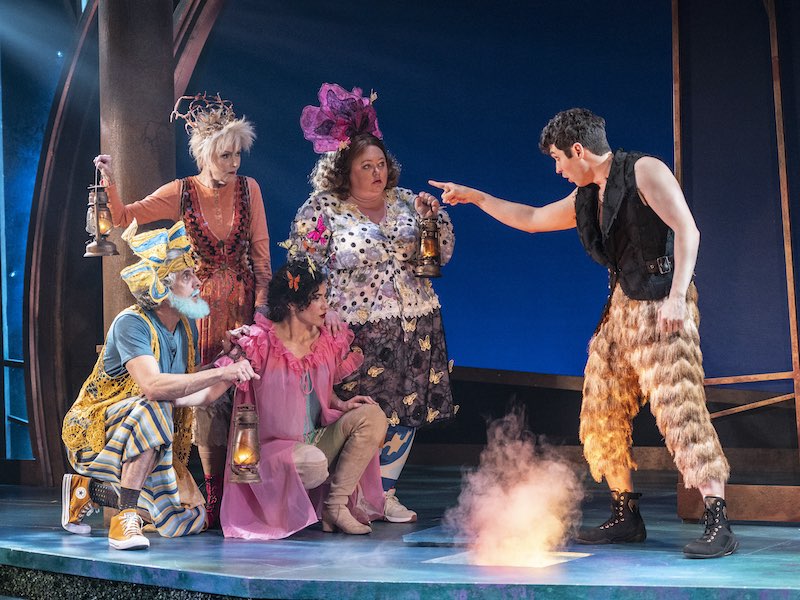
The four soon reappear in the first act as Helena, Hermia, Demetrius, and Lysander. The production’s fresh approach—casting four middle-aged actors as the young Athenian lovers—both plays to the strengths of Everyman’s ensemble and creates a beautiful study of nostalgia and how our formative teen years create who we become, whether repressing or heartily embracing youthful desires. (There is precedent for playing with casting ages, such as 82-year-old Sir Ian McKellan playing the youthful Danish prince in Theatre Royal Windsor’s 2021 production of Hamlet .)
This Midsummer hinges on the existential question posed by John Hughes, the director of white, suburban, Midwest, teenage comedies of the 1980s, in The Breakfast Club : “My God, are we gonna be like our parents?”
Nelson is a randy, raunchy Lysander and he finds little comedic tics at every opportunity, such as when he bests a foe using only the auburn locks of his wig (Denise O’Brien’s fantastic wigs top many heads in this play). Hazlett offers pathos as the dismissed Helena who still pines for Demetrius and follows at his heels like a spurned spaniel. Russell is a feisty Demetrius, always ready for a brawl. And Rathnam shines as Hermia, a little spitfire with a black fringed bob and a canary-colored dress, who speaks in an affected manner, overstressing the heroic rhymes of this poetic comedy to great effect. They quite literally throw themselves on one another in wooing scenes, and the slapstick fighting among the four even includes that worst fate of middle school arguments: purple nurples. The follies of youth extend well beyond the teen years, showing that our deepest fears and desires don’t really grow and evolve. What fools these (middle-aged) mortals be!
The production offers time travel by interpolating music that would’ve been popular when the lovers were at prom or starring in their high school Shakespeare production in the 1980s: pop songs by the likes of David Bowie and Janet Jackson and from the era’s film soundtrack standards ( Dirty Dancing, Labyrinth) punctuate scene changes, the cast dances and lip syncs to Jefferson Starship, and Puck plays an acoustic guitar and Rickrolls the crowd by singing Rick Astley’s “Never Gonna Give You Up.” We all know the power of a favorite song to bring us back to a first kiss, slow dance, or breakup, and the sound design by Pornchanok Kanchanabanca plays with aural nostalgia with aplomb.
The delightfully ingenious costumes for the Athenian lovers by David Burdick also hint at prom attire (cummerbunds, formal menswear worn with Converses, or Hermia’s dress covered by a zipped hoodie and backpack) without becoming too literal or looking silly on the adult cast. (Likewise, Burdick’s costuming is smartly themed across the production from the Rude Mechanicals’ penchant for denim, the fairies dressed like children putting on all their favorite, neon-colored mismatched pieces and tutus at once, the beautiful regal wear of the two royal couples, and Puck’s fringed trousers that hint at a faun’s shaggy goat legs.)

The world of the fairies where the lovers find themselves is a place of magic but also menacing. As the royals—both the divine fairies Titania and Oberon, and the Athenian king Theseus and his Amazon bride Hippolyta—Andreá Bellamore and René Thornton Jr. (both in their Everyman debuts) are regal and beautiful, but also petty, jealous, petulant, and sometimes cruel. Zack Powell brings all the zaniness and mayhem as the mischievous sprite Puck, dashing across the stage, flashing a brilliant smile, strumming his guitar, and gracefully climbing the stage’s scaffolding.
There is magic galore—love potions, time stopping, sleights of hand, and more (Aja M. Jackson’s exquisite lighting design, original music by Kanchanabanca, quick-paced choreography by Shalyce Hemby, and Lewis Shaw leading intimacy and fight sequences) add to this mystical world. This leads to a sense of darkness and danger: the fairies’ feud has led to a climate catastrophe, the lovers are manipulated and humiliated before pairing off into couples again, Bottom is transformed into a donkey, and even Puck expresses fear of haunted spirits in the woods. And can one ever really forgive Oberon for his cruel trick against Titania in making her engage in bestiality and also stealing her adopted son (portrayed by a sympathetic puppet), the child of a dead beloved friend?
Titania’s train of playful and bewitching spirits played by Suzanna Catherine Fox, Helen Hedman, Hanah Kelly, and James Whelan double as the incredibly funny Rude Mechanicals, and Tony Nam leads the acting troupe as the bombastic but good-natured Bottom. Only the second Shakespeare production for Everyman, this particular play with its focus on an acting troupe aligns so beautifully with the rarity of Everyman Theatre’s resident acting company. These actors develop trust and relationships by working together so often, and anticipate each other’s movements and choices so deeply. It’s always a joy to see how much fun they seem to have in each other’s company.
A highlight of any Midsummer worth its weight in pixie dust is the final play-within-a-play, and this one’s no exception. Fox is a naughty Flute/Thisbe who gyrates every time she mentions Ninus’ tomb; Kelly brings big musical theater kid energy to her role as the plucky playwright Quince/Moonshine; Whalen plays the role of Snout/Wall “most obscenely”; and Hedman is a “harmless necessary cat” (to quote Merchant of Venice ) as Snug, which is comically unfortunate as she should embrace the role of a roaring, fearful Lion. There are so many mishaps in their “Pyramus and Thisbe”—misplaced swords, bad blockings, forgotten lines, and a tumble down the stairs—that someone must’ve said the Scottish thane’s name before they took the stage.
The induction scene is frameworked by a series of subtle and un-magical transformations back into the real world—through an onstage costume change, Titania and Oberon turn into Hippolyta and Theseus; Bottom’s donkey head is removed; the fairies take the stage in their all too mortal forms as the Rude Mechanicals; and even the charming Puck becomes the bumbling, bookish Philostrate. But the lovers all seem renewed, refreshed, and younger than in the beginning of the play. As the whole ensemble dances to another Fleetwood Mac classic, “Gypsy,” the entire theater is lit up with festooned lights and chandeliers. And that—the entire process of stopping two hours in the real world, entering a spectral, fantastical place, leaving renewed and transformed by others who also went on the same weird, wild journey—is magical, too.
In The Breakfast Club , the question posed—“My God, are we gonna be like our parents?”—elicits shock and denial from the group of rebellious teens. No one wants to grow up, to care more about retirement funding than romance, to become boring and dull and old. Allison (Ally Sheedy) concedes, “It’s unavoidable, it just happens. … When you grow up, your heart dies…” This wonderful and joyous production of A Midsummer Night’s Dream is so lovely, lively, and magical that it disproves those teenage fears.
Running time: Two hours with a 15-minute intermission.
A Midsummer Night’s Dream plays through June 9, 2024, at Everyman Theatre, 315 West Fayette St., Baltimore, MD. Purchase tickets ($29–$75) online or contact the box office by phone at 410-752-2208 (Monday–Friday, 10 a.m.–4 p.m., and Saturday, 12-4 p.m.) or email [email protected] .
Accessibility: Everyman emphasizes their commitment to accessibility for all, including those with economic challenges, with Pay What You Choose prices.
The cast and creative credits are online here (scroll down).
COVID Safety: Masks are encouraged, though not required. Everyman’s complete health and safety guide is here.
A Midsummer Night’s Dream By William Shakespeare Directed by Noah Himmelstein
RELATED ARTICLES MORE FROM AUTHOR

‘Reefer Madness’ is ridiculously high on fun at NextStop Theatre
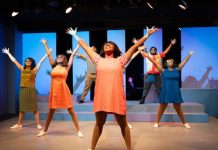
‘Bubbly Black Girl Sheds Her Chameleon Skin’ soars at Creative Cauldron
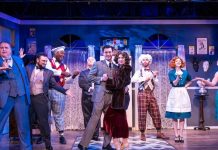
Workhouse Arts Center delivers a rollicking good ‘Drowsy Chaperone’
Leave a reply cancel reply.
Save my name, email, and website in this browser for the next time I comment.
- International
- Schools directory
- Resources Jobs Schools directory News Search

KS3: Creative Writing (linked to A Midsummer Night's Dream)
Subject: English
Age range: 11-14
Resource type: Lesson (complete)
Last updated
27 January 2018
- Share through email
- Share through twitter
- Share through linkedin
- Share through facebook
- Share through pinterest

Tes paid licence How can I reuse this?
Get this resource as part of a bundle and save up to 61%
A bundle is a package of resources grouped together to teach a particular topic, or a series of lessons, in one place.
Creative Writing Bundle
A whole mash of creative writing resources - some paid, some not - all in one place!
Year 8 English Curriculum
A series of resources that constitute a year 8 curriculum.
Your rating is required to reflect your happiness.
It's good to leave some feedback.
Something went wrong, please try again later.
This resource hasn't been reviewed yet
To ensure quality for our reviews, only customers who have purchased this resource can review it
Report this resource to let us know if it violates our terms and conditions. Our customer service team will review your report and will be in touch.
Not quite what you were looking for? Search by keyword to find the right resource:

IMAGES
VIDEO
COMMENTS
A Midsummer Night's Dream video, worksheet, answers, transcript, character flashcards and games: ... creative writing skills by imagining and writing about either a magical dream or a magic potion or spell. Procedure 1. Introduce and watch the video (15 mins)
Creative writing: Q2 - Here is an example of what you can expect your question 2 to look like: Either: Write a story opening that starts at a circus. Or Write a description/story using the image below as inspiration. You should practise writing a description/story for each of the images. You should aim to write a minimum on one page per image.
The activities provided in this pack are specifically designed to support KS1-3 pupils in their writing and offers a number of writing opportunities centred around A midsummer Night's Dream, exploring the story, characters and vocabulary. In the 'notes from the classroom' boxes you will find helpful hints and suggestions for how activities
Midsummer NIght's dream creative writing task. Subject: Plays. Age range: 11-14. Resource type: Worksheet/Activity. File previews. docx, 17.49 KB. stimulus to retell the story. Not quite what you were looking for? Search by keyword to find the right resource:
In A Midsummer Night's Dream, characters like Hermia and Lysander rebel against societal expectations in several ways. ... Creative Writing: Teachers could assign creative writing tasks such as writing alternate endings or creating modern adaptations of the play. This task encourages students' creativity while allowing them to practice ...
Choose from one of the following creative writing projects tied to A Midsummer Night's Dream, and then share it aloud with the class, as practice for the final assessment. You may complete the tasks independently, with a partner, or in a small group of 4 or less. Creative Writing Options: Reader's Theatre Script (minimum 300 words)
Age range: 11-14. Resource type: Lesson (complete) File previews. pptx, 384.78 KB. Targeted at Year 7, this creative writing lesson, which could easily be split into two, uses A Midsummer Night's Dream as a stimulus text. It is intended to complement the study of the play, but could quite easily be used as a standalone image source for ...
Keywords. Patriarchal - a society in which men hold the power; the laws and structure of that society prevent women having power.. Hierarchy - a system whereby people or things are ranked, with some being at the top, and others lower down.. Elizabethan - a person alive when Elizabeth I was on the throne (1558-1603); the first audiences of 'A Midsummer Night's Dream' were Elizabethan.
Creative writing: Design a set for the production of A Midsummer Night's Dream. 16 Extension: Oberon is frustrated at Puck's carelessness. Read through Act 3 Scene 2 from line 88 and find examples of Oberon's frustration and Puck's delight at causing confusion. Research: We see Puck is a mischievous and naughty character.
Activity 3: College to Adult: Visual Art of Midsummer Nights' Dream Project. Objective: Design costumes and setting for Dream to get the students thinking about the visual language of the play, which takes place in three very distinct locations. Materials needed- depends on the format.
This creative writing project is designed for students to apply a scene from William Shakespeare's A Midsummer Night's Dream to another time period and adapt the story and its themes for an audience of the era.. PDF format for ready-to-go printing. This resource is also available at a discounted price in our A Midsummer Night's Dream Complete Resource Bundle.
Age range: 11-14. Resource type: Worksheet/Activity. File previews. doc, 3.27 MB. Scaffolded writing task for A Midsummer Night's Dream. Ideal as a homework, for cover, or to include in your unit of work! Creative Commons "Sharealike". This resource hasn't been reviewed yet. To ensure quality for our reviews, only customers who have ...
Ideal as a KS3 introduction to 'A Midsummer Night's Dream, this comprehensive set of guided activities includes: researching William Shakespeare, a quick anagram task, introductions to the main characters, a scaffolded Agony Aunt letter and diary entry tasks from Hermia and Puck's point of view. suitable for lower-attaining students.
pptx, 1.83 MB. This PPT has 2 whole lessons that can be used as a Creative Writing assessment while studying A Midsummer Night's Dream. This PPT can be used with year 8 onwards and it is lined up with the new AQA specifications for English Language (descriptive writing with a picture stimulus). I hope you will find it helpful.
Created by. Creative Primary Literacy. This is a play script for William Shakespeare's A Midsummer Night's Dream, which has been rewritten to be suitable for ages 9 to 14. A Midsummer Night's Dream tells the story of four Athenian lovers who have a complicated yet dramatic love life.
William Shakespeare's A Midsummer Night's dream is complicated enough to provide no shortage of writing prompts and essays questions. Whether in respect to the entire play, a character analysis or ...
A creative lesson to engage students and structure creative writing. Groups of resources for a lesson on narrative structure in A Midsummer Night's Dream. Includes Teaching Ideas, PowerPoint and Storyboard.Tags in this resource: mount-st-helens.pngks3-lightbulb.pnglysander.pnghermia.pnghelena.pngdemetrius.pngballet-dancer.pngsmiley-face.pngLit-Match-Black-and-White.pngLit-Match.pngWishing-Wa
Embark on an enchanting journey through the world of A Midsummer Night's Dream with our dynamic and growing bundle! Immerse your students in each act of Shakespeare's timeless play, fostering engagement through a range of creative writing prompts, interactive discussions, captivating word searches, 9. Products. $6.00 $10.50 Save $4.50.
A Midsummer Night's Dream Writing. Subject: English. Age range: 5-7. Resource type: Lesson (complete) File previews. pptx, 1.16 MB. PNG, 1.74 MB. PNG, 1.7 MB. A lesson focusing on building confidence in writing alongside the play A Midsummer Night's Dream by William Shakespeare.
A Midsummer Night's Dream is a perfect play for exploring Shakespeare's diverse uses of language to reveal character and themes, from formal iambics and rhyming couplets of courtiers and lovers, and 'warbling' notes' and nursery rhythms of fairies, to stocky prose by the artisan players including Bottom's comic malapropisms.
A powerpoint presentation designed to enhance student's creative writing skills, with a focus on describing the enchanted forest from A Midsummer Nights Dream.
KS3 Creative Writing One-Offs. A series of resources aimed at developing writing practice. Stimulus images from A Midsummer Night's Dream and Victorian England are the focus for two lessons while a lesson exploring tension and skills needed for the written element of English Language paper 1 make up the other two resources.
A Midsummer Night's Dream plays through June 9, 2024, at Everyman Theatre, 315 West Fayette St., Baltimore, MD. Purchase tickets ($29-$75) online or contact the box office by phone at 410-752-2208 (Monday-Friday, 10 a.m.-4 p.m., and Saturday, 12-4 p.m.) or email [email protected]. Accessibility: Everyman emphasizes their ...
Creative Writing Bundle. A whole mash of creative writing resources - some paid, some not - all in one place! £15.00. This resource hasn't been reviewed yet. Not quite what you were looking for? Search by keyword to find the right resource: After teaching content related to AMND, we had changed direction and ended up doing some creative writing.